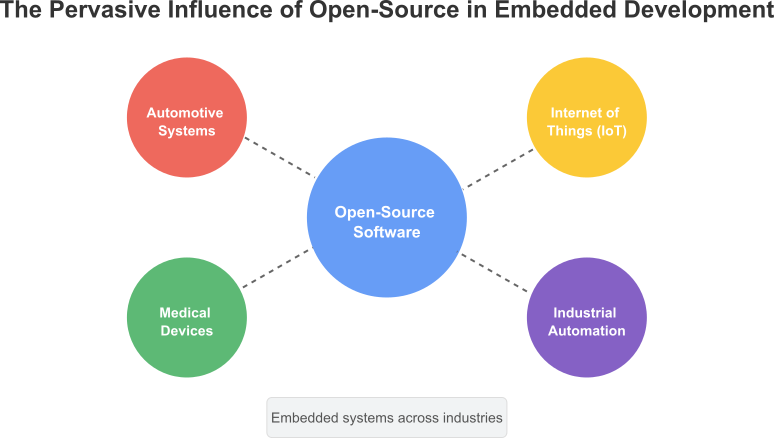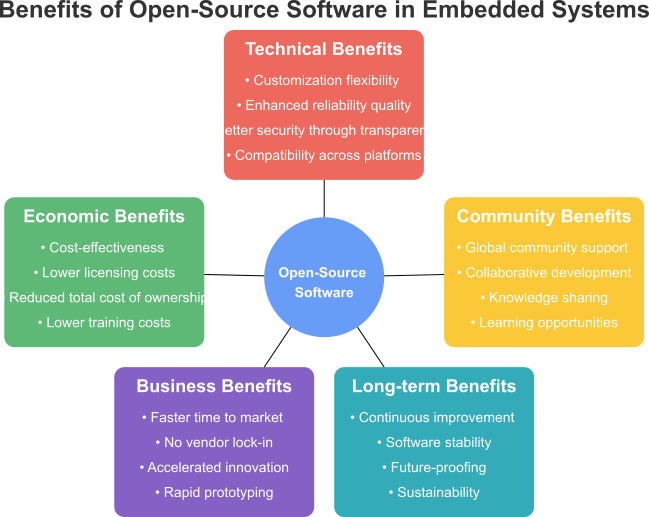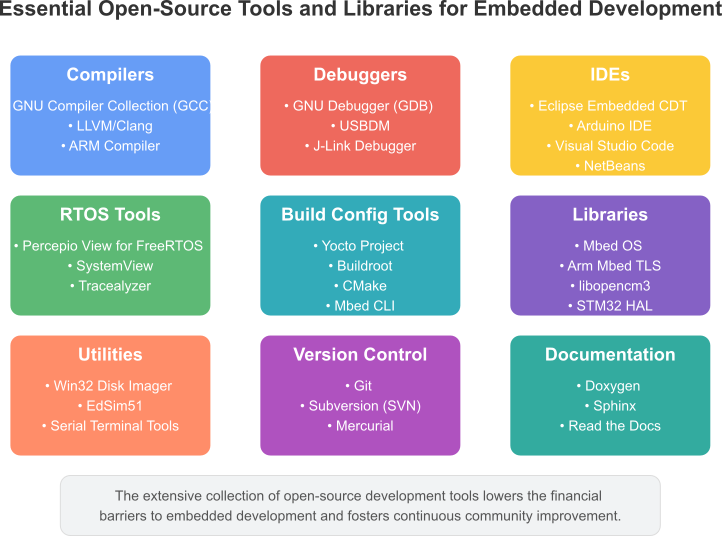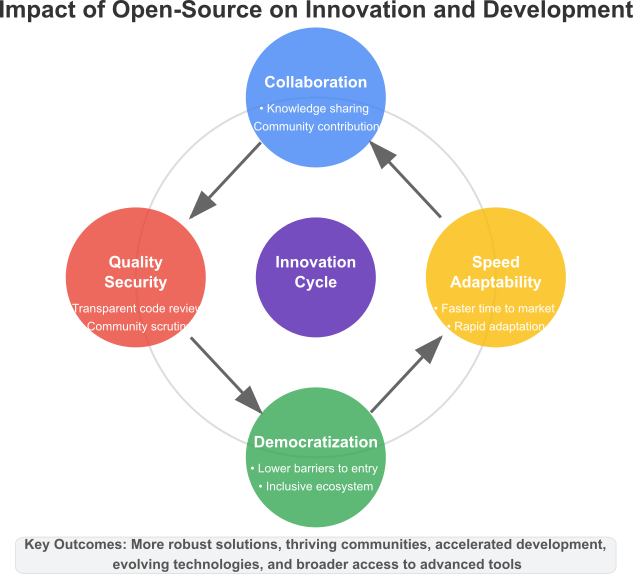
The Indispensable Role of Open-Source Software in Modern Embedded Development
1. Introduction: The Pervasive Influence of Open-Source Software in Modern Embedded Development
Embedded systems, specialized computer systems designed to perform dedicated functions within larger mechanical or electrical systems, are increasingly integral to modern technology. From the intricate controls of automotive systems and the vast networks of the Internet of Things (IoT) to the sophisticated functionalities of medical devices, embedded systems are the unseen intelligence driving a multitude of industries 1. In the broader software landscape, open-source software (OSS) has witnessed a significant surge in adoption, becoming a cornerstone of innovation and development across various domains 2. This trend is particularly pronounced in the realm of embedded development, where open-source solutions are rapidly transforming how systems are conceived, designed, and deployed 1.

Understanding the multifaceted role of open-source software, including its advantages, inherent challenges, and profound impact on innovation within embedded development, is crucial for developers, businesses, and anyone seeking to comprehend the trajectory of modern technology. The increasing complexity and interconnectedness of contemporary embedded systems appear to be a significant factor propelling the adoption of open-source solutions. These systems, moving beyond simple standalone functionalities, are now often integrated into extensive networks, demanding increasingly sophisticated capabilities. Open-source software, with its inherent modularity and the collaborative nature of its development, offers a compelling approach to address this growing complexity, potentially providing greater flexibility compared to more restrictive proprietary alternatives 4.
2. Defining the Open-Source Paradigm: Core Principles and Characteristics
Open-source software (OSS) is fundamentally characterized by the availability of its source code, allowing users the freedom to utilize, modify, and distribute the software along with its original rights 6. This accessibility to the underlying code distinguishes it from proprietary or closed-source software, where the source code remains inaccessible for editing, limiting the user’s control and understanding 2. The core concept of OSS revolves around the accessibility of the software’s source code to anyone, granting the liberty to alter or enhance the software to meet specific needs under defined licensing terms 4. This fundamental principle of openness underpins several core values that define the open-source ethos. These include the freedom to redistribute the software without restriction, ensuring its widespread availability 9. The provision of source code is mandatory, facilitating its distribution in both source and compiled forms 9. Furthermore, the license must permit modifications and the creation of derivative works under the same licensing terms as the original software 9. While the integrity of the author’s original source code can be protected, the distribution of modified versions through patch files must be allowed 9.
mindmap
root((Open-Source<br>Paradigm))
(Core Principles)
[Source Code Availability]
[Freedom to Modify]
[Freedom to Redistribute]
[No Discrimination]
[Technology Neutrality]
(Open-Source Culture)
[Collaborative Participation]
[Transparency]
[Meritocracy]
[Community-Driven]
[Inclusivity]
[Do-ocracy]
(Licensing Terms)
[GNU Public License]
[MIT License]
[Apache License]
[BSD License]
(Historical Context)
[Richard Stallman 1983]
[GNU Project]
[Open Source Initiative 1998]Open-source licenses are inherently non-discriminatory, prohibiting any bias against individuals, groups, or specific fields of endeavor 9. The rights associated with the software must extend to all who receive it, without the need for additional licensing agreements 9. Moreover, the license should not be specific to a particular product or impose restrictions on other software or technologies distributed alongside it 9. Beyond these licensing stipulations, a culture of open exchange prevails, emphasizing the free availability and accessibility of information and code 8. Collaborative participation and shared responsibility are central tenets, where collective effort and contributions from a diverse community drive the development process 8. Transparency and security are enhanced through the open nature of the code, allowing for broad scrutiny and the identification of potential vulnerabilities 4. Development is often community-driven, guided by the needs and contributions of its users and developers 4. A spirit of meritocracy and inclusivity ensures that contributions are evaluated based on their quality and impact, fostering an environment where diverse perspectives are valued 10. Finally, the principle of do-ocracy empowers those actively involved and contributing to have a significant say in the project’s direction 10.
The roots of the open-source movement can be traced back to 1983, with Richard Stallman’s ideological belief in the accessibility and modifiability of software, leading to the creation of the GNU Public License 7. The foundational principles of open source extend beyond mere software licensing; they embody a comprehensive philosophy centered on collaboration, transparency, and community-driven innovation. The historical context and the core values associated with open source reveal that it is not simply a pragmatic solution but also an ideological movement dedicated to democratizing software development and access to technology 4.
3. The Evolving Landscape of Embedded Development: Current Trends and Emerging Challenges
The field of embedded development is undergoing rapid transformation, driven by several key trends. Edge computing, which involves processing data closer to its source rather than relying solely on centralized cloud infrastructure, is gaining significant traction 12. This trend is closely linked with the increasing integration of artificial intelligence (AI) and machine learning (ML) into embedded systems, enabling devices to make smarter, real-time decisions 12. The proliferation of interconnected devices has also elevated the importance of cybersecurity, leading to increasing cybersecurity mandates and a greater emphasis on implementing robust security measures in embedded systems 12. Modern software development practices, including DevOps methodologies with continuous integration and continuous deployment (CI/CD) pipelines, are also being adopted in embedded engineering to streamline development processes and improve efficiency 12. System on Chip (SoC) integration, which combines various system components onto a single integrated circuit, is becoming increasingly common, driven by the demand for smaller, more efficient devices 12. Sensor fusion, the process of combining data from multiple sensors to provide a more comprehensive understanding of the environment, is also a significant trend 12. Ensuring the seamless coexistence and interoperability of diverse devices within interconnected ecosystems presents another key trend 16. The computational demands of ML applications are also driving the development of new chip architectures specifically optimized for these workloads 16. Furthermore, modern programming languages like Rust, known for their safety and efficiency features, are gaining popularity in embedded applications, challenging the traditional dominance of C 14.
The Evolving Landscape of Embedded Development
Current Trends
Persistent Challenges
The Impact of Open-Source Software
Open-source software addresses several key challenges in embedded development:
- Helps overcome resource constraints through efficient, optimized code
- Enhances reliability and robustness via community testing and peer review
- Improves security through transparency and collective vulnerability detection
- Provides scalability and flexibility with modifiable source code
- Reduces costs by eliminating licensing fees
- Accelerates time-to-market with reusable components
However, emerging trends like edge computing, AI integration, and increased connectivity are intensifying challenges related to resource constraints and security vulnerabilities.
The adoption of versatile Integrated Development Environments (IDEs) like Visual Studio Code is also on the rise due to their usability and extensive feature sets 14. The need for real-time data processing in various applications is pushing embedded software towards decentralized and edge-driven architectures 13. Finally, energy efficiency remains a critical concern, especially for battery-powered embedded devices, driving innovations in low-power design and software optimization 13. Alongside these advancements, embedded development faces several persistent and emerging challenges. Resource constraints, including limitations in memory, processing power, and energy availability, continue to pose significant hurdles for developers 18. Many embedded systems have stringent real-time performance requirements, demanding timely and deterministic execution of tasks 12. Ensuring the reliability and robustness of embedded systems is paramount, as unexpected failures can have severe consequences, particularly in critical applications 18. The increasing connectivity of embedded devices has amplified security vulnerabilities, making it essential to protect against unauthorized access and data breaches 12. Designing systems with sufficient scalability and flexibility to adapt to future upgrades and changing requirements remains a challenge 19. Integrating embedded systems seamlessly with other systems and ensuring smooth data exchange is also a complex task 19. Developers often face tight cost constraints, requiring them to balance performance with budget limitations 17. The increasing complexity of device development, driven by consumer demand for more features and capabilities, adds another layer of difficulty 14. Ensuring compatibility and maintaining the integrity of connections between different devices and systems is crucial for seamless operation 18. The pressure for speed and rapid time-to-market further complicates the development process 18. Selecting the appropriate hardware platform that meets all the project requirements is a critical early challenge 23. Designing intuitive user interfaces for embedded systems with limited display and input options can also be a significant challenge 19. Issues related to stability, safety, design limitations, compatibility, and speed are consistently reported as key difficulties 18. Furthermore, incomplete or poorly defined project requirements can lead to significant problems later in the development cycle 17. The trends shaping embedded development, particularly the growing prevalence of IoT and AI, are intensifying existing challenges such as security and resource limitations. This makes the adaptability and community-driven security enhancements inherent in open-source software increasingly pertinent for addressing these evolving needs. The demand for smarter, connected devices necessitates that embedded systems handle more complex tasks and communicate across networks, thereby expanding the potential attack surface and placing greater demands on constrained resources. Open-source solutions facilitate customization and community-based security improvements that can effectively tackle these emerging requirements 5.
4. Unlocking the Potential: Benefits of Open-Source Software in Embedded Systems
The adoption of open-source software in embedded systems development offers a multitude of compelling benefits. One of the most significant advantages is cost-effectiveness. Open-source software is often available with free or nominal licensing and usage charges, resulting in reduced overall costs for licensing and allowing organizations to allocate resources to other crucial areas like hardware 7. This can lead to a lower total cost of ownership compared to proprietary alternatives, translating to substantial savings for businesses, especially those with limited resources 11. Moreover, the wealth of community-generated documentation and support can also reduce training costs 27. Another key benefit is the high degree of customization and flexibility offered by open-source solutions. Developers have the freedom to examine the source code, understand its inner workings, and make modifications to suit their specific requirements and needs 7. This adaptability is invaluable for addressing unique problems and tailoring software to specific hardware and application constraints 5. Furthermore, the absence of vendor lock-in provides the freedom to explore different solutions and adapt to evolving project needs without being tied to a single proprietary vendor 5. Open-source fosters excellent collaboration and development within a global community of developers 4. This collaborative environment facilitates rapid software development, with a vast community of contributors continuously providing updates, improvements, and bug fixes 24. Leveraging the collective knowledge and expertise of this community can significantly benefit every stage of product development 24. The reliability and quality of open-source software are often high, as the code is continuously reviewed and tested by a global community, ensuring it is largely free from vulnerabilities and bugs, offering stable and dependable solutions 5. The peer-review process inherent in open-source development contributes to better quality and enhanced security 5. Engaging with the community also leads to faster resolution of coding issues 27.

Open-source software fuels innovation and accelerates time to market. Programmers can leverage pre-existing code to improve software and develop innovative solutions 7. The ability to quickly build upon existing codebases allows for rapid prototyping and iteration, significantly speeding up the development process 8. By incorporating open-source code, developers can often bring products to market faster than if they were building everything from scratch 3. The built-in community support is another significant advantage. The continuous modification and improvement of source code by the community ensure the software remains up-to-date and relevant 7. Developers can also tap into the free support and expertise of a global online community for assistance and guidance 25. Engaging with these communities often provides access to peer-reviewed solutions and expedites problem-solving 27. Open-source software provides invaluable learning opportunities for new programmers, allowing them to examine and modify real-world software applications, gaining practical experience and insights 7. The transparency of open-source code allows developers to thoroughly check and track data flow and code changes, fostering trust and security within the community 5. Furthermore, the public distribution of source code ensures the stability and long-term availability of open-source software, as it is not dependent on a single vendor or author 5. Finally, open-source solutions can boost compatibility across various hardware platforms. Standardized interface specifications like POSIX promote uniformity, allowing applications to operate seamlessly across different hardware without extensive modifications 27. Containerization can further reduce compatibility issues, and the use of Real-Time Operating Systems (RTOS) can simplify interactions with diverse hardware architectures 27. The numerous benefits of open-source software in embedded development address not only technical aspects like flexibility and reliability but also crucial business considerations such as cost and time-to-market. The open and collaborative nature of open-source creates a positive cycle where cost savings attract more users and developers, leading to more robust and innovative solutions, which in turn further reduces costs and accelerates development 4.
5. Powering Embedded Systems: Popular Open-Source Operating Systems
A variety of open-source operating systems are commonly employed in modern embedded systems, each offering unique features and catering to different application requirements. Linux, particularly in its various embedded distributions, stands out as a widely used option due to its open-source nature and extensive community support 31. Its high degree of flexibility and scalability allows it to be customized for a wide range of embedded applications, from simple devices to complex systems 31. Embedded Linux distributions are often favored for their low cost, lightweight storage requirements, and ability to run on relatively fewer resources 32. The stability of the Linux kernel is another significant advantage 32. Popular examples of embedded Linux distributions include Yocto, Buildroot, OpenWrt/LEDE, and Raspberry Pi OS 32. These distributions find applications in devices such as smart TVs and network routers 31. Notably, Tesla has adopted Linux for its in-car infotainment systems, citing faster feature updates and improved user experience 15. FreeRTOS is another prominent open-source operating system, specifically designed as a real-time operating system (RTOS) for microcontrollers and small microprocessors 24. It is characterized by its small memory footprint, low overhead, and a rich set of features 24. FreeRTOS is considered one of the most widely deployed RTOS in the embedded space, supporting over 40 processor architectures 33. Distributed freely under the MIT open-source license, it is used in various applications, including industrial automation, robotics, sensors, and home automation systems 24. SAFeRTOS, a safety-critical RTOS, is also built upon the functional model of FreeRTOS 34. Zephyr is another popular open-source RTOS gaining traction in the embedded world 15. This project boasts a large community of contributors and comprehensive documentation, making it a robust choice for various embedded applications 27. Beyond these leading options, other open-source operating systems also play significant roles in embedded development. Android, while primarily known as a mobile operating system, is open-source and finds use in certain embedded applications requiring a user-friendly interface and a large ecosystem of applications 31. Other options include Apache Mynewt, Contiki OS, which is specifically designed for low-memory devices, RTEMS (Real-Time Executive for Multiprocessor Systems), and LiteOS from Huawei 31.
The widespread adoption of open-source operating systems such as Linux, FreeRTOS, and Zephyr underscores the commitment of the open-source community to providing dependable and adaptable foundations for a diverse range of embedded applications, spanning from resource-limited microcontrollers to more powerful and complex systems. The availability of these well-supported open-source OSes lowers the barrier to entry for embedded development, enabling developers to build upon existing work rather than starting from scratch, thereby accelerating innovation and reducing development timelines.
6. The Embedded Developer’s Toolkit: Essential Open-Source Tools and Libraries
The open-source ecosystem provides a rich set of essential tools and libraries that empower embedded developers throughout the entire development lifecycle. Compilers, such as the GNU Compiler Collection (GCC), are fundamental tools used to translate high-level programming languages into machine code executable by embedded processors. GCC is a widely adopted open-source compiler suite that supports a broad range of programming languages and processor architectures. Debuggers are equally critical for identifying and resolving issues in embedded software. The GNU Debugger (GDB) is a popular open-source debugger that allows developers to trace program execution, inspect variables, and identify the root causes of errors 27. USBDM is another open-source tool that provides debugging and programming interfaces specifically for Freescale microcontrollers 37. Integrated Development Environments (IDEs) streamline the development process by providing a comprehensive suite of tools in a single application. Eclipse Embedded CDT is an open-source IDE that enhances the development of embedded applications using C and C++ 24. NetBeans is another free and open-source IDE that supports multiple programming languages and offers features like code editing, project management, debugging, and a rich set of plugins 38. The Arduino IDE, while primarily associated with the Arduino platform, is an open-source IDE that simplifies the creation of programs for Arduino microcontrollers 38. Visual Studio Code, with its growing popularity, has become a versatile IDE for embedded development, especially with the availability of various extensions that provide support for different embedded platforms and toolchains 14. For developers working with Real-Time Operating Systems (RTOS), specific open-source tools are available. Percepio View for FreeRTOS is a free tracing tool that aids in the debugging and analysis of FreeRTOS applications 33.

Build and configuration tools are essential for managing the complexity of embedded software projects. The Yocto Project is a powerful open-source tool that provides developers with tools, metadata, and templates to create custom Linux-based embedded systems 24. Buildroot offers a more lightweight alternative to Yocto for building embedded Linux systems 32. Mbed CLI is a command-line tool provided by Arm for managing Mbed OS projects 39. In addition to these core tools, a wide array of other open-source utilities and libraries are available for embedded development. Win32 Disk Imager is a useful tool for writing operating system images to USB drives or SD cards, a common task in embedded development 37. EdSim51 is an open-source simulator designed for students and educators to learn about the 8051 microcontroller architecture 37. Mbed OS itself is a free and open-source IoT operating system and development platform provided by Arm, offering a comprehensive set of tools and libraries for rapid IoT device development 39. Arm Mbed TLS is another valuable open-source library that provides SSL/TLS capabilities for embedded products, enhancing security 39. libopencm3 is an open-source library specifically designed for ARM Cortex-M microcontrollers, providing low-level hardware access 40. Finally, community-driven resources like the Awesome-Embedded GitHub repository serve as comprehensive lists of various open-source tools, libraries, and resources relevant to embedded development 40. The extensive collection of open-source development tools available covers all stages of the embedded development process, from the initial code creation and compilation to debugging, build automation, and operating system support. The accessibility and cost-free nature of these powerful tools significantly lower the financial barriers to embedded development, enabling developers to prioritize innovation rather than focusing on the costs associated with proprietary software licenses. Furthermore, the collaborative spirit of the open-source community ensures the continuous improvement and adaptation of these tools to meet the evolving demands of the embedded systems field.
7. Navigating the Complexities: Challenges and Considerations When Using Open-Source Software
While open-source software offers numerous benefits in embedded development, it also presents several challenges and considerations that developers must address. Licensing issues are a significant concern, as numerous open-source licenses exist, each with its own set of requirements and obligations 7. Many licenses necessitate the inclusion of a copy of the license text when distributing the licensed software, which can be cumbersome in embedded systems with limited storage or display capabilities 41. Displaying copyright notices, a requirement of some licenses, can also be challenging in embedded devices without easy access to a file system 41. Failure to comply with license terms can lead to legal repercussions, including cease-and-desist letters and potential lawsuits 41. Furthermore, certain open-source licenses may impose limitations on the monetization of derivative works, which can be a concern for commercial projects 25. Security concerns are another critical aspect to consider. Open-source software, while benefiting from community scrutiny, can still contain vulnerabilities in its code due to various factors 7. The interconnected nature of open-source projects through dependency chains means that a vulnerability in one component can potentially affect numerous other projects 22. Insecure default configurations in some open-source software can also create security risks 22. The threat of supply chain attacks, where malicious actors compromise open-source components, is also a growing concern 22.
flowchart LR
OSS[Open-Source Software in Embedded Systems] --> L[Licensing Issues]
OSS --> S[Security Concerns]
OSS --> E[Expertise Requirements]
OSS --> CS[Community Support Limitations]
OSS --> W[Warranty & Liability]
L --> L1[Numerous license types with different requirements]
L --> L2[License text inclusion requirements]
L --> L3[Copyright notice display challenges]
L --> L4[Legal risks for non-compliance]
L --> L5[Monetization limitations]
S --> S1[Potential code vulnerabilities]
S --> S2[Dependency chain risks]
S --> S3[Insecure default configurations]
S --> S4[Supply chain attacks]
S --> S5[Limited security resources on devices]
S --> S6[Need for continuous vulnerability scanning]
E --> E1[Significant customization requirements]
E --> E2[Technical complexity vs proprietary solutions]
E --> E3[Hardware/software adaptation challenges]
CS --> CS1[No guaranteed response times]
CS --> CS2[Limited context-specific assistance]
CS --> CS3[Inconsistent project direction]
W --> W1[Limited or no warranties]
W --> W2[No liability protection]
W --> W3[No infringement indemnity]
classDef main fill:#6495ED,stroke:#333,stroke-width:2px,color:white;
classDef section fill:#4682B4,stroke:#333,stroke-width:1px,color:white;
classDef detail fill:#87CEFA,stroke:#333,stroke-width:1px,color:black;
class OSS main;
class L,S,E,CS,W section;
class L1,L2,L3,L4,L5,S1,S2,S3,S4,S5,S6,E1,E2,E3,CS1,CS2,CS3,W1,W2,W3 detail;The limited resources available on many embedded devices can further complicate the implementation of robust security measures 19. Therefore, continuous scanning for and patching of vulnerabilities are essential when using open-source software in embedded systems 22. The successful integration of open-source software often requires a significant degree of customization and in-house expertise 7. Compared to some proprietary solutions, open-source tools may be more technically demanding and less user-friendly for individuals without coding expertise 7. Adapting open-source components to specific hardware and software requirements can also necessitate considerable effort. While community support is a valuable asset of the open-source model, it may not always provide the guaranteed response times or context-specific assistance that commercial vendors typically offer 25. Online support forums may not address highly specific or unique project challenges 25. Additionally, the decentralized nature of some large community-driven projects can sometimes lead to inconsistencies in code quality and project direction 26. Unlike commercial software, open-source software typically does not come with warranties, liability protection, or infringement indemnity 7. This places the responsibility for ensuring legal compliance and addressing potential issues squarely on the user 7. Despite the numerous advantages of open-source, developers must be acutely aware of the potential challenges related to licensing, security, and the necessity for specialized knowledge to effectively utilize these solutions in embedded systems. The freedom and flexibility inherent in open-source development come with the responsibility of ensuring adherence to licensing terms and proactively addressing security vulnerabilities. Unlike proprietary software, where these aspects are often managed by the vendor, with open-source, the onus falls on the developer and the organization to manage these complexities effectively.
8. Fueling Innovation and Accelerating Development: The Impact of Open-Source
Open-source software serves as a significant catalyst for innovation within the embedded industry, fostering an environment of collaboration and shared knowledge. Developers can leverage existing open-source codebases as building blocks, accelerating the creation of new features and technologies rather than starting from scratch 4. The collaborative nature of open-source projects encourages experimentation and the open exchange of ideas, leading to more creative and effective solutions that might not emerge in closed, proprietary settings 26. The collective approach inherent in open-source development often results in faster problem-solving and the generation of innovative solutions 29. The ability to rapidly build and iterate on existing code allows for quicker prototyping and a more agile development process 8. The open and transparent nature of open-source development leads to improved software quality and security. The rigorous scrutiny by a diverse group of developers facilitates the rapid identification and resolution of bugs and security vulnerabilities 26. The transparency of the code allows for thorough audits, enhancing trust and the overall security posture of the software 5. Open-source software also plays a crucial role in democratizing technology within the embedded industry. By reducing the costs associated with software licenses and decreasing dependency on proprietary vendors, open-source solutions enable a wider range of developers and organizations, including startups and small businesses, to access advanced tools and technologies 4. This broader access fosters a more inclusive and innovative ecosystem 1.

The open-source movement has fostered the growth of thriving communities and ecosystems around various projects. This collaborative environment encourages knowledge sharing, mutual support, and the collective development of software 4. These communities often produce extensive support resources, including forums, documentation, and shared best practices 29. The ability to reuse and modify existing open-source code significantly accelerates the development process, leading to faster time to market for embedded products 3. The community-driven nature of bug fixes and updates also contributes to quicker release cycles 11. Furthermore, open-source software demonstrates a remarkable adaptability and capacity for evolution. The open nature of the code allows it to quickly adapt to meet new needs and incorporate emerging technological trends 28. The continuous improvement driven by community contributions ensures the long-term relevance and sustainability of open-source solutions 5. Open-source software acts as a powerful engine for innovation in the embedded industry by promoting collaboration, lowering the barriers to entry, and accelerating the development and enhancement of software solutions. The open and collaborative nature of these projects creates a continuous feedback loop of contribution, review, and refinement, resulting in more robust, secure, and innovative embedded systems than might be achievable with closed, proprietary development models.
9. Open-Source in Action: Case Studies of Successful Embedded Systems
Numerous real-world examples demonstrate the successful application of open-source software in embedded systems across various domains. ADES, a Belgian company, developed a cost-effective 360-degree remote inspection system utilizing open-source software, which significantly expanded their market reach and yielded a substantial return on investment 30. The INES project highlighted 19 best practice case studies showcasing the benefits of using OSS in industrial embedded systems, leading to improved performance and reduced costs 30. DeepSea Developments created an open-source macropad based on the ESP32 microcontroller, incorporating Bluetooth and Wi-Fi connectivity, demonstrating the versatility of open-source in creating custom hardware 42. The Java Open Processor (JOP) has been successfully deployed in critical industrial applications, including distributed control systems in the railway domain, with the majority of these applications being open-source, allowing for community review and contribution 43. Tesla’s decision to adopt Linux for its in-car infotainment system underscores the suitability of open-source for complex embedded systems requiring frequent updates and a rich feature set 15.
Case Studies: Open-Source Success in Embedded Systems
The Awesome-Embedded GitHub repository serves as a testament to the vast number of open-source projects available for popular embedded platforms like Raspberry Pi, ESP32, and STM32, including bootloaders, real-time operating system ports, and various libraries 40. Furthermore, Android, an open-source operating system, powers a significant portion of the global smartphone market and is also utilized in a range of other embedded devices, showcasing the scalability and adaptability of open-source solutions 31. These diverse case studies illustrate the practical advantages of employing open-source software in a wide array of embedded applications, from industrial automation and control to consumer electronics and automotive systems, highlighting its adaptability and effectiveness in addressing real-world challenges. These examples provide tangible evidence of the benefits of open-source, such as reduced development costs, faster time to market, and increased flexibility, making a compelling argument for its continued adoption in embedded development.
10. Conclusion: The Indispensable Role of Open-Source in the Future of Embedded Development
In conclusion, open-source software has firmly established itself as an indispensable component of modern embedded development. Its key benefits, including cost-effectiveness, unparalleled flexibility, robust community support, and the acceleration of innovation, address many of the critical demands of this rapidly evolving field. While challenges such as licensing complexities and security considerations require careful attention and proactive mitigation strategies, the advantages offered by open-source solutions are undeniable.
mindmap
root((Open-Source in<br>Embedded Development))
(Key Benefits)
[Cost-effectiveness]
[Unparalleled flexibility]
[Robust community support]
[Acceleration of innovation]
(Notable Challenges)
[Licensing complexities]
[Security considerations]
[Expertise requirements]
[Support limitations]
(Impact on Innovation)
[Democratizing advanced technologies]
[Fostering collaboration]
[Speed to market]
[Building on shared knowledge]
(Future Outlook)
[Growing significance]
[Increased adoption]
[Community evolution]
[Technological advancement]
(Call to Action)
[Embrace the ecosystem]
[Contribute to growth]
[Actively participate]
[Ensure future innovation]The impact of open-source on fostering innovation and speeding up development cycles within the embedded industry is profound, democratizing access to advanced technologies and enabling developers to build upon a vast foundation of shared knowledge and code. As demonstrated by numerous successful case studies across diverse applications, open-source software empowers developers and businesses to create sophisticated and efficient embedded systems. Looking ahead, the role of open-source software in embedded development is only set to grow in significance. Developers and businesses are encouraged to not only embrace the open-source ecosystem but also actively contribute to its continued growth and evolution, ensuring a future of collaborative innovation and technological advancement in the embedded world.
Reference Works
- The Future of Embedded Software: Enabling SMarcher Devices Across Industries, access date March 27, 2025, https://softworldinc.com/innovation-insights/softworld-partners-with-ma-non-profit
- What Is Open Source Software? – IBM, access date March 27, 2025, https://www.ibm.com/think/topics/open-source
- How software-defined SoCs and open-source tools are shaping embedded systems, access date March 27, 2025, https://www.electronicspecifier.com/products/design-automation/how-software-defined-socs-and-open-source-tools-are-shaping-embedded-systems
- What is Open Source Software?, access date March 27, 2025, https://opensource.psu.edu/project/what-is-open-source-software/
- What is open source? – Red Hat, access date March 27, 2025, https://www.redhat.com/en/topics/open-source/what-is-open-source
- www.blackduck.com, access date March 27, 2025, https://www.blackduck.com/glossary/what-is-open-source-software.html#:~:text=Black%20Duck%20help%3F-,Definition,distribution%20with%20its%20original%20rights.
- What Is Open Source Software and How Does It Work? | Black Duck, access date March 27, 2025, https://www.blackduck.com/glossary/what-is-open-source-software.html
- Open source – Opendatasoft, access date March 27, 2025, https://www.opendatasoft.com/en/glossary/open-source/
- The Open Source Definition, access date March 27, 2025, https://opensource.org/osd
- Open source culture: 9 core principles and values – Red Hat, access date March 27, 2025, https://www.redhat.com/en/blog/open-source-culture-9-core-principles-and-values
- What is Open Source Software (OSS)? – GitHub, access date March 27, 2025, https://github.com/resources/articles/software-development/what-is-open-source-software
- Top 5 Trends and Innovations in Embedded Engineering for 2024 | Cutting-Edge Insights, access date March 27, 2025, https://www.arigs.com/blog/top-5-trends-and-innovations-in-embedded-engineering-in-2024/
- What’s Next for Embedded Software? Trends to Watch in 2025 – PureSoftware, access date March 27, 2025, https://www.puresoftware.com/blog/top-embedded-software-trends-to-watch-in-2025
- Embedded Software Engineering Trends, access date March 27, 2025, https://www.embedded.com/embedded-software-engineering-trends/
- Charting the Future of Embedded Systems I Industrial Innovation Trends, access date March 27, 2025, https://www.momenta.one/insights/industrial-innovation-trends-momenta
- 6 Embedded Software Development Trends to Watch in 2024 | ICS, access date March 27, 2025, https://www.ics.com/blog/6-embedded-software-development-trends-watch-2024
- 7 common challenges during hardware design and development for embedded systems, access date March 27, 2025, https://woodswallow.tech/common-challenges-hardware-design-development-embedded-systems/
- Embedded Systems Development: Challenges | Incredibuild, access date March 27, 2025, https://www.incredibuild.com/blog/how-to-overcome-these-6-key-challenges-in-embedded-systems-development
- Top 10 Challenges in Embedded System Design and Their Solutions, access date March 27, 2025, https://www.rsystems.com/blogs/top-10-challenges-in-embedded-system-design-and-their-solutions/
- Top 10 Challenges in Embedded Software Development & How to Overcome Them, access date March 27, 2025, https://www.saracasolutions.com/blogs/addressing-the-top-10-challenges-in-embedded-software-development-with-practical-solutions
- Challenges and Issues of Embedded Software Development – Infopulse, access date March 27, 2025, https://www.infopulse.com/blog/challenges-and-issues-of-embedded-software-development
- Understanding open source security risks in IoT applications – Embedded, access date March 27, 2025, https://www.embedded.com/understanding-open-source-security-risks-in-iot-applications/
- Embedded System Design: Challenges of Hardware and Software Development, access date March 27, 2025, https://www.integrasources.com/blog/embedded-system-design-challenges/
- The Impact of Open Source Tools on Embedded Software Development – Sunstream Global, access date March 27, 2025, https://www.sunstreamglobal.com/the-impact-od-open-source-tools-on-embedded-software-development/
- Open Source vs. Proprietary Solutions in Embedded Development – rinf.tech, access date March 27, 2025, https://www.rinf.tech/open-source-vs-proprietary-solutions-in-embedded-development/
- How Open Source Changed Software Development! – Cogent University, access date March 27, 2025, https://www.cogentuniversity.com/post/how-open-source-changed-software-development
- The Role of Open-Source Tools in Revolutionizing Embedded Software Engineering, access date March 27, 2025, https://moldstud.com/articles/p-the-role-of-open-source-tools-in-embedded-software-engineering
- What is Open Source: Understanding Its Impact on Technology and Innovation, access date March 27, 2025, https://algocademy.com/blog/what-is-open-source-understanding-its-impact-on-technology-and-innovation/
- The Impact of Open Source on Software Development: Collaboration Over Competition | by Emperor Brains | Medium, access date March 27, 2025, https://medium.com/@emperorbrains/the-impact-of-open-source-on-software-development-collaboration-over-competition-4d8ce85c3bfa
- Open Source Gains Ground in Industrial Embedded Systems – Innovations Report, access date March 27, 2025, https://www.innovations-report.com/science-tech/information-technology/report-28519/
- Best Operating Systems for Embedded Systems with Examples, access date March 27, 2025, https://embeddedhash.in/operating-systems-for-embedded-systems/
- Which Linux Distro is Best for Embedded Development? – TuxCare, access date March 27, 2025, https://tuxcare.com/blog/which-linux-distro-is-best-for-embedded-development/
- FreeRTOS™ – FreeRTOS™, access date March 27, 2025, https://www.freertos.org/
- What Are the Most Popular Real-Time Operating Systems in 2024?, access date March 27, 2025, https://www.lynx.com/blog/most-popular-real-time-operating-systems-rtos
- www.google.com, access date March 27, 2025, https://www.google.com/search?q=popular+open-source+operating+systems+for+embedded+systems
- Best Embedded Operating Systems Reviews 2025 | Gartner Peer Insights, access date March 27, 2025, https://www.gartner.com/reviews/market/embedded-operating-systems
- Best Open Source Embedded Systems Software 2025 – SourceForge, access date March 27, 2025, https://sourceforge.net/directory/embedded-systems/
- Top 10 Embedded Software Development Tools – Sam Solutions, access date March 27, 2025, https://www.sam-solutions.com/blog/top-ten-embedded-software-development-tools/
- Mbed: Free open source IoT OS and development tools from Arm, access date March 27, 2025, https://os.mbed.com/
- A curated list of awesome embedded programming. – GitHub, access date March 27, 2025, https://github.com/nhivp/Awesome-Embedded
- Embedded systems and open source software | reuschlaw News, access date March 27, 2025, https://www.reuschlaw.de/en/news/embedded-systems-and-open-source-software/
- 15 Real Life Embedded Systems Examples – DeepSea Developments, access date March 27, 2025, https://www.deepseadev.com/en/blog/embedded-systems-examples/
- Educational case studies with an open source embedded real-time Java processor, access date March 27, 2025, https://www.researchgate.net/publication/228763586_Educational_case_studies_with_an_open_source_embedded_real-time_Java_processor


